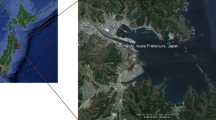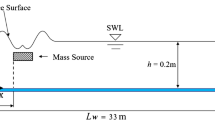Abstract
The hybrid numerical model had been developed to simulate a complicated 3D flow around structures generated by tsunami. In the model, the conventional 2D model is adopted for the wide region far from structures and the 3D non-hydrostatic pressure model is used in the limited region adjacent to structures. The applicability of the model is shown by comparisons of the numerical results with the experimental results of the laboratory model tests and the numerical analysis results of the conventional whole 2D simulation. In addition, the effect of a submerged structure at the opening of a breakwater is discussed from the numerical simulations by the hybrid model. The submerged structure improves the stability of the rubble mound and reduces the tsunami inflow into the bay, while it increases the water surface velocity around the opening of the breakwater. The increase of surface velocity causes the increases of impulsive forces by collision with drafts and so on.
Similar content being viewed by others
References
Fujima K (2002) Review: development of numerical wave flume CADMAS-SURF (SUper Roller Flume for Computer Aided design of Maritime Structure). Proc Coastal Ocean Eng Korea 13(1):1–13
Fujima K, Masamura K, Goto C (2002) Development of the 2D/3D hybrid model for tsunami numerical simulation. Coastal Eng J 44(4):373–397
Goto C, Ogawa Y (1997) IUGG/IOC TIME PROJECT: numerical method of tsunami simulation with the leapfrog scheme, part 1 shallow water theory and its difference scheme. In: International Oceanographic Commission, Manual and guides, UNESCO, vol 35, p 43
Imamura F (1996) Review of tsunami simulation with a finite difference model. In: Long-wave runup models. World Scientific Publishing, pp 25–42
Masamura K, Fujima K (1996) Three-dimensional analysis of long wave runup on a conical island by using the MAC method. In: Long-Wave Runup Models, World Scientific Publishing, pp 321–331
Masamura K, Fujima K, Hayashi K, Shigemura T, Goto C (1996) A three-dimensional numerical model of tsunami with non-hydrostatic pressure. Proc Coastal Eng 43:296–300 (in Japanese)
Nakatsuji K, Karino S, Kurita H (1992) Finite element analysis of tidal flow in the osaka bay with subgrid scale eddy coefficient. Proc Hydraulic Eng 36:693–696 (in Japanese)
Sakakiyama T, Kajima R (1992) Numerical simulation of nonlinear wave interacting with permeable breakwaters. Proc 23rd Int Conf Coastal Eng 2:1517–1530
Shuto N, Goto C, Imamura F (1990) Numerical simulation as a means of warning for near-field tsunami. Coastal Eng Jpn 33(2):173–193
Smagorinsky J (1963) General circulation experiments with the primitive equations. I. The basic experiments. Monthly Weather Rev 91:99–164
Tanimoto K, Kimura K, Miyazaki K (1988) Study on stability of submerged dike at the opening section of tsunami protection breakwaters. Report of the Port and Harbour Research Institute (PHRI), Japan, Vol. 27(4):93–121 (in Japanese)
Author information
Authors and Affiliations
Corresponding author
Rights and permissions
About this article
Cite this article
Fujima, K. Effect of a submerged bay-mouth breakwater on tsunami behavior analyzed by 2D/3D hybrid model simulation. Nat Hazards 39, 179–193 (2006). https://doi.org/10.1007/s11069-006-0022-x
Received:
Accepted:
Issue Date:
DOI: https://doi.org/10.1007/s11069-006-0022-x




